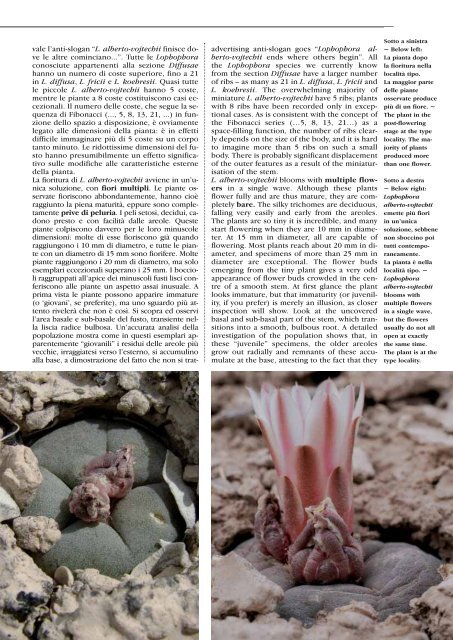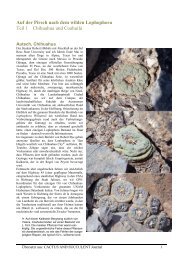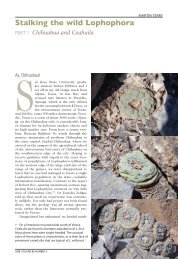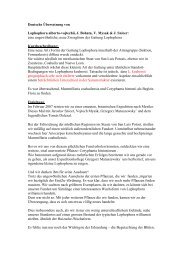alberto-vojtechii - Lophophora.info
alberto-vojtechii - Lophophora.info
alberto-vojtechii - Lophophora.info
Create successful ePaper yourself
Turn your PDF publications into a flip-book with our unique Google optimized e-Paper software.
vale l’anti-slogan “L. <strong>alberto</strong>-<strong>vojtechii</strong> finisce dove<br />
le altre cominciano...”. Tutte le <strong>Lophophora</strong><br />
conosciute appartenenti alla sezione Diffusae<br />
hanno un numero di coste superiore, fino a 21<br />
in L. diffusa, L. fricii e L. koehresii. Quasi tutte<br />
le piccole L. <strong>alberto</strong>-<strong>vojtechii</strong> hanno 5 coste,<br />
mentre le piante a 8 coste costituiscono casi eccezionali.<br />
Il numero delle coste, che segue la sequenza<br />
di Fibonacci (..., 5, 8, 13, 21, ...) in funzione<br />
dello spazio a disposizione, è ovviamente<br />
legato alle dimensioni della pianta: è in effetti<br />
difficile immaginare più di 5 coste su un corpo<br />
tanto minuto. Le ridottissime dimensioni del fusto<br />
hanno presumibilmente un effetto significativo<br />
sulle modifiche alle caratteristiche esterne<br />
della pianta.<br />
La fioritura di L. <strong>alberto</strong>-<strong>vojtechii</strong> avviene in un’unica<br />
soluzione, con fiori multipli. Le piante osservate<br />
fioriscono abbondantemente, hanno cioè<br />
raggiunto la piena maturità, eppure sono completamente<br />
prive di peluria. I peli setosi, decidui, cadono<br />
presto e con facilità dalle areole. Queste<br />
piante colpiscono davvero per le loro minuscole<br />
dimensioni: molte di esse fioriscono già quando<br />
raggiungono i 10 mm di diametro, e tutte le piante<br />
con un diametro di 15 mm sono fiorifere. Molte<br />
piante raggiungono i 20 mm di diametro, ma solo<br />
esemplari eccezionali superano i 25 mm. I boccioli<br />
raggruppati all’apice dei minuscoli fusti lisci conferiscono<br />
alle piante un aspetto assai inusuale. A<br />
prima vista le piante possono apparire immature<br />
(o ‘giovani’, se preferite), ma uno sguardo più attento<br />
rivelerà che non è così. Si scopra ed osservi<br />
l’area basale e sub-basale del fusto, transiente nella<br />
liscia radice bulbosa. Un’accurata analisi della<br />
popolazione mostra come in questi esemplari apparentemente<br />
“giovanili” i residui delle areole più<br />
vecchie, irraggiatesi verso l’esterno, si accumulino<br />
alla base, a dimostrazione del fatto che non si trat-<br />
advertising anti-slogan goes “<strong>Lophophora</strong> <strong>alberto</strong>-<strong>vojtechii</strong><br />
ends where others begin”. All<br />
the <strong>Lophophora</strong> species we currently know<br />
from the section Diffusae have a larger number<br />
of ribs – as many as 21 in L. diffusa, L. fricii and<br />
L. koehresii. The overwhelming majority of<br />
miniature L. <strong>alberto</strong>-<strong>vojtechii</strong> have 5 ribs; plants<br />
with 8 ribs have been recorded only in exceptional<br />
cases. As is consistent with the concept of<br />
the Fibonacci series (…5, 8, 13, 21…) as a<br />
space-filling function, the number of ribs clearly<br />
depends on the size of the body, and it is hard<br />
to imagine more than 5 ribs on such a small<br />
body. There is probably significant displacement<br />
of the outer features as a result of the miniaturisation<br />
of the stem.<br />
L. <strong>alberto</strong>-<strong>vojtechii</strong> blooms with multiple flowers<br />
in a single wave. Although these plants<br />
flower fully and are thus mature, they are completely<br />
bare. The silky trichomes are deciduous,<br />
falling very easily and early from the areoles.<br />
The plants are so tiny it is incredible, and many<br />
start flowering when they are 10 mm in diameter.<br />
At 15 mm in diameter, all are capable of<br />
flowering. Most plants reach about 20 mm in diameter,<br />
and specimens of more than 25 mm in<br />
diameter are exceptional. The flower buds<br />
emerging from the tiny plant gives a very odd<br />
appearance of flower buds crowded in the centre<br />
of a smooth stem. At first glance the plant<br />
looks immature, but that immaturity (or juvenility,<br />
if you prefer) is merely an illusion, as closer<br />
inspection will show. Look at the uncovered<br />
basal and sub-basal part of the stem, which transitions<br />
into a smooth, bulbous root. A detailed<br />
investigation of the population shows that, in<br />
these “juvenile” specimens, the older areoles<br />
grow out radially and remnants of these accumulate<br />
at the base, attesting to the fact that they<br />
Sotto a sinistra<br />
~ Below left:<br />
La pianta dopo<br />
la fioritura nella<br />
località tipo.<br />
La maggior parte<br />
delle piante<br />
osservate produce<br />
più di un fiore. ~<br />
The plant in the<br />
post-flowering<br />
stage at the type<br />
locality. The majority<br />
of plants<br />
produced more<br />
than one flower.<br />
Sotto a destra<br />
~ Below right:<br />
<strong>Lophophora</strong><br />
<strong>alberto</strong>-<strong>vojtechii</strong><br />
emette più fiori<br />
in un’unica<br />
soluzione, sebbene<br />
non sboccino poi<br />
tutti contemporaneamente.<br />
La pianta è nella<br />
località tipo. ~<br />
<strong>Lophophora</strong><br />
<strong>alberto</strong>-<strong>vojtechii</strong><br />
blooms with<br />
multiple flowers<br />
in a single wave,<br />
but the flowers<br />
usually do not all<br />
open at exactly<br />
the same time.<br />
The plant is at the<br />
type locality.







